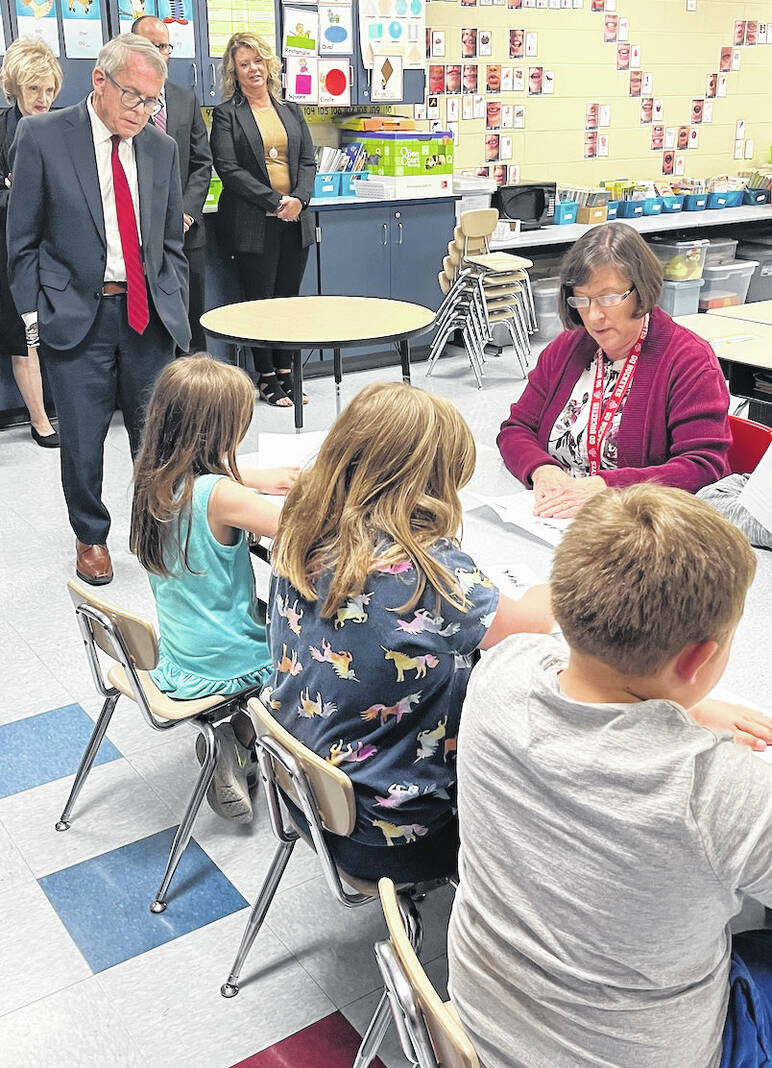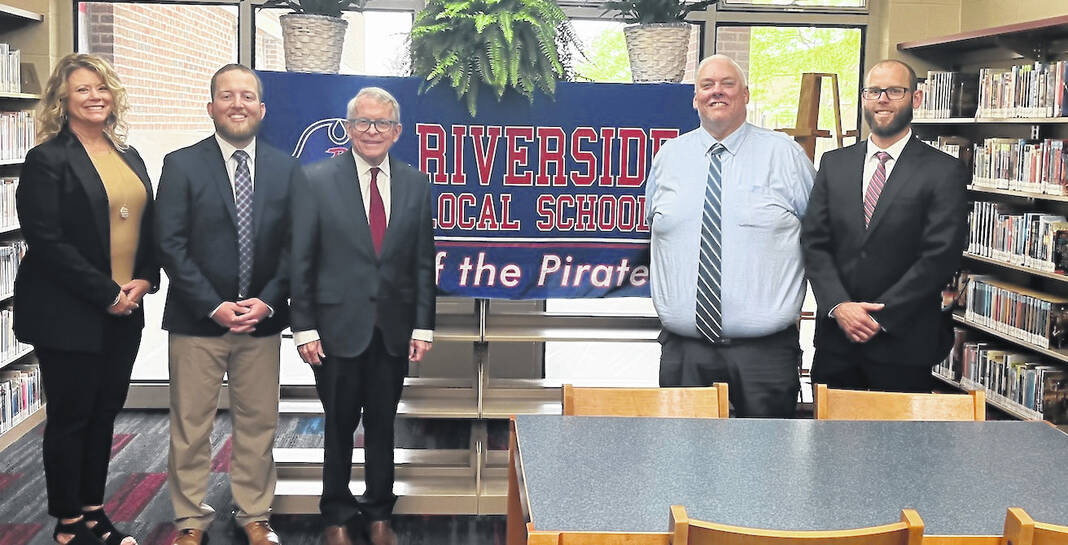
Gov. Mike DeWine observing Melanie Easton’s first grade class on Monday, May 15, to see the curriculum in action.
Amantha Garpiel | Sidney Daily News

On hand for Gov. Mike DeWine’s visit to Riverside Elemantary School were, left to right Kelly Kauffman, middle and high school principal; Bryce Hodge, preschool through 12th grade principal; DeWine; Superintendent Dr. Scott Mann,; and Seth Meyer, assistant principal.
Amantha Garpiel | Sidney Daily News
By Amantha Garpiel
DEGRAFF — Ohio Gov. Mike DeWine visited Riverside Elementary School in DeGraff to experience how the implementation of reading instruction, fueled by the science of reading, has been beneficial to staff and students at Riverside Elementary.
During his visit on Monday, May 15, DeWine sat down with school administration and Literacy Specialist Margo Shipp to gain a better understanding of how implementing a curriculum based in the science of reading has changed the school since the 2017-2018 school year. The science of reading is knowledge taught to teachers and is based on how individuals learn to read. Riverside Elementary School uses McGraw Hill’s core reading program, Open Court, and The Heggerty Curriculum’s phonemic awareness, both based in the science of reading.
“Any new intitive is always tough, but our teachers bought in, our aides bought in, our kids have bought in, it’s now the norm,” said Superintendent Dr. Scott Mann. “Everyone has to be rowing the boat the same way.”
Mann noted a student who came to Riverside Elementary School after being in online schooling for the first two years of his education, kindergarten and first grade, who initially read six words per minute and after one academic year learning with curriculum based in the science of reading now reads 101 words per minute.
“It’s (science of reading based curriculum) improved their reading ability for sure,” said Shipp. “I think it’s given them confidence, I think it’s improved the climate because everyone feels like they can become a reader. Teachers feel confident because they know what to do when a child is not reading at grade level; they know exactly what to do, they can diagnose and they can intervene. I think it just builds a whole building that’s on the same page. Everybody’s working towards the same thing.”
Outside of what curriculum is used in the elementary school, Shipp shared with DeWine that the implementation of LETRS Training for all teachers across the school has been increasingly beneficial. According to Shipp and the administration requiring all teachers in the school to obtain LETRS Training has put every teacher, across grade levels, on the same page and has them “speaking the same language.” Maintaining the universal understanding of literacy benefits students as well as the teachers.
Another aspect of learning implemented at Riverside Elementary School is the inclusion of a daily 50 minute intervention for every student in the school no matter whether they are at, below or above the literacy benchmark. All teachers participate in the interventions at the same time as the schools’ intervention specialists. Each child receives the intervention they need, in small groups, to make improvements. The group intervention sessions has allowed the school to maintain the continuity of the kids’ education by reducing how often students are pulled out of their core classes for one-on-one interventions. The students who were being pulled from class for intervention still receive the assistance they need, just without missing out on their regular classroom learning.
After sitting down with the school’s administration, DeWine visited Melanie Easton’s first-grade classroom and Christina Mann’s second-grade classroom to see the curriculum and LETRS training in action. DeWine saw the teachers in action and their different boards posted in their classrooms as reminders for students; in Easton’s classroom she has a letter board with photos to show students the shapes their mouths should make when pronouncing each letter of the alphabet. Then, in Mann’s classroom, he was able to see the Heggerty Phonemic Awareness in action as Mann sat with her students sounding out the phonics of words, adding and subtracting phonics to make different words and having her students phonetically spell different words.
Riverside is the 12th elementary school DeWine has visited that has transistioned to curriculum based in the science of reading during the last few years to see the results. He hopes, should the budget proposed to the Ohio General Assembly be approved by the beginning of July, that more schools will begin to receive government assistance to begin transitioning to literacy learning based in the science of reading.
“What the evidence really shows today is that, curriculums that are based on the science of reading, kids do so much better, in regards to reading,” said DeWine. “To state the obvious, reading is the key to life really.”
“Our goal overall is for every Ohioan to be able to live up to their full potential, every child to live up to their full potential. So, it’s important that we make this transition. Some schools, as you’ve seen today, have already made it and are continuing to move forward. Other schools have not done it at all. What we want, is for every school to do it for every child, no matter where they live, no matter what school they go to, to have the benefit of the best science we have today,” said DeWine.
According to DeWine, the evidence is clear that using curriculum based in the science of reading is the best way.
“As I’ve said, I’m a former county prosecuting attorney and the way I refer to it is; the jury has returned, there is a verdict and the verdict is that this is the best way to do it,” said DeWine. “One of our challenges is to get all of our colleges that are preparing teachers to make this switch over (to science of reading based education).”

